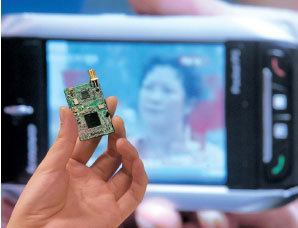
A mobile TV clip developed by
Beijing-based manufacturer,Innofidei Inc.[China Daily]
 |
From mobile TV chips to digital
recognition scanners that can pick out disguised terrorists by reading their
facial bone structures, the Beijing Games is expected to showcase new
technological innovations that will make peopel's lives easier, safer or simply
more fun.
When the
world of science fiction meets the world of sports, it seems, anything is
possible.
|
From tree branches to Teflon:
How technology has moved forward at the Summer
Olympics
Athens 1896: As swimming pools were not available, swimmers had
to compete in the open sea. Swimmers were taken out to sea by boat
and were supposed to swim back in any style of their choosing.
Paris 1900: Long-jump athletes had to dig the jumping pit by
themselves, and tree branches were used to set the height of the
hurdles.
Stockholm 1912: Electric stop watches and photo finishes
were used to improve the accuracy of results to within 0.1
second.
Antwerp 1920: A stadium that could seat 30,000 spectators
was built. A cinder track, which was 400m in circumference, was used
for the first time as a standard track.
Amsterdam 1928: The
Olympic flame was lit for the first time using a condensing
lens.
Berlin 1936: With the invention of television in the early
1920s, the Olympic Games was shown on television for the first
time.
Melbourne 1956: A plane was employed for the first time to
carry the Olympic fire tinder. It flew for more than 20,000 km from
Mount Olympia to Melbourne.
Rome 1960: Stimulants made their
first appearance at the Games when Danish cyclist Knud Enemark
Jensen died mid-competition after having consumed a cocktail of
narcotics.
Tokyo 1964: A communications satellite was employed to
broadcast the Games for the first time to the entire
world.
Mexico City 1968: Electronic stop watches helped improve
the accuracy of official competition records to within 0.01
second.
Munich 1972: Upgraded stop watches moved to within 0.001
second accuracy. Cameras, laser equipment and computers were widely
used to decide a dead heat, when a stop watch could not separate the
two runners.
Montreal 1976: A satellite was used to transmit
Olympic fire signals, and a laser gun was used to light up the
Olympic torch.
Barcelona 1992: A computer network was used to
connect all the stop watches and result recorders.
Sydney 2000:
An information management system was widely used to record athletes'
results, which were also put up on the official website for the
Games. The new generation Teflon-coated swimming bodysuit made its
debut.
Athens 2004: Running shoes that deflect heat and sweat,
swimsuits that imitate the flow dynamics of shark's skin or planes,
and "cool" woollen clothing that kept athletes comfortable between
events in high temperatures were used to improve their
performance.
| |
The
Olympics has long been a test bed for new technological innovations. With
security a higher priority in the post-September 11 world, one of the showcase
gadgets that may be introduced to Beijing's Olympic Village this year enables
apartment doors to recognize their guests using codes that are almost impossible
to crack.
"Once you get to the door, a linked-up camera captures the features of your
face, including your bone structure," said Chinese inventor Ma Xin. "These
features are then translated into codes, which are forwarded to a computer and
crosschecked with a database. As long as your codes do not correspond to any
'bad codes,' that is, those belonging to people on our blacklist, the door will
open."
Ma was explaining the functions of the device to an audience at last month's
Olympic technology exhibition, part of Beijing Science and Technology Week.
"The camera can pick a (potential terrorist) out of a large crowd," he said,
"The whole process takes about 1/100 of a second."
Ma said that even wigs, sunglasses and make-up would not be able to fool the
computer by masking the person's identity.
"Even if the suspect changes his hairstyle or gains a lot of weight, the door
can still recognize him," he said. Ma has a PhD from the Chinese Academy of
Sciences and is a member of the Security Advisory Committee for the 2008 Beijing
Olympics.
The door, which is expected to be installed at Olympic venues and the Olympic
Village, could also be used in regular households across China.
This could signal the end of house keys, meaning one less headache for the
forgetful and one major obstacle for pickpockets and burglars.
Of course, security is only one aspect of the Games, and something that most
people would prefer not to concern themselves with as they sit back and enjoy
watching sporting history in the making.
With another innovation in the offing, viewers will be able to take in the
action while walking to the office, taking a bus or simply waiting in line for
lunch.
Beijing-based Innofidei Inc claims to have developed the first mobile TV chip
for the domestic market, potentially transforming hundreds of thousands of
mobile handsets into micro-TVs.
The technology is based on a domestic specification called China Mobile
Multimedia Broadcasting (CMMB), which was approved by the State Administration
for Radio, Film and Television (SARFT) last September.
With this chip, people can receive TV signals on their phones and watch
programs without any temporal or space-based restrictions.
"As long as the handset terminal has a colored screen and a battery, our chip
can turn it into a mobile TV," said Meng Fei, director of Innofidei's business
development department. "The chip can be plugged into a cell phone, a PDA, an
MP4, a digital camera or even a laptop.
| 1 | 2 |  |